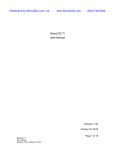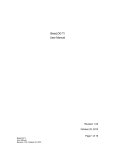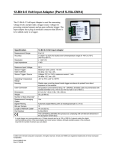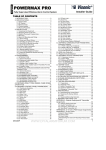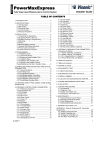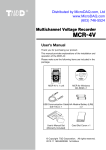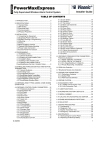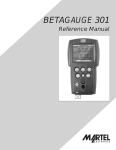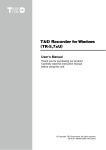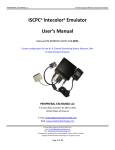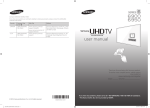Download BETALOG Data Logging User`s Manual
Transcript
BETALOG Data Logging User’s Manual Distributed by MicroDAQ.com, Ltd www.MicroDAQ.com (603) 746-5524 BETALOG Data Logging User’s Manual 1. Introduction . . . . . . . . . . . . . . . . . . . . . . . . . . . . . . . . . . .1 2. Description . . . . . . . . . . . . . . . . . . . . . . . . . . . . . . . . . . . .1 3. Gauge Operation . . . . . . . . . . . . . . . . . . . . . . . . . . . . . . . .5 3.1 Data Logging Disabled . . . . . . . . . . . . . . . . . . . . . . . . . . . .5 3.2 Download Mode . . . . . . . . . . . . . . . . . . . . . . . . . . . . . . . . .5 3.3 Demand Mode . . . . . . . . . . . . . . . . . . . . . . . . . . . . . . . . . .7 4. BetaLOG Microsoft Windows Application . . . . . . . . . . . .9 4.1 Installation and Registration . . . . . . . . . . . . . . . . . . . . . . . . .9 4.2 Menus . . . . . . . . . . . . . . . . . . . . . . . . . . . . . . . . . . . . . . . .10 4.3 Main Display . . . . . . . . . . . . . . . . . . . . . . . . . . . . . . . . . . .12 4.4 Log Upload Display . . . . . . . . . . . . . . . . . . . . . . . . . . . . . .16 4.5 Display Options . . . . . . . . . . . . . . . . . . . . . . . . . . . . . . . . .17 4.6 Export Options . . . . . . . . . . . . . . . . . . . . . . . . . . . . . . . . .18 5. Excel Templates . . . . . . . . . . . . . . . . . . . . . . . . . . . . . . .21 5.1 Single Run Graph . . . . . . . . . . . . . . . . . . . . . . . . . . . . . . .22 5.2 Single Run Pressure and Tempeature Graph . . . . . . . . . . .22 6. Warranty . . . . . . . . . . . . . . . . . . . . . . . . . . . . . . . . . . . . .23 TRADEMARKS . . . . . . . . . . . . . . . . . . . . . . . . . . . . . . . . . . . . .24 Distributed by MicroDAQ.com, Ltd www.MicroDAQ.com (603) 746-5524 1. Introduction This Manual describes the data logging capability and operation of the pressure gauge, plus the operation of the related BetaLOG Microsoft Windows application. All BetaGauge PI's with firmware with revision 3.0 or higher are capable of data logging when used with the BetaLOG software. This manual complements and extends the user manual received with the pressure gauge. Please refer to the gauge manual for additional information on its operation. The BetaLOG application is used to configure logging parameters in the gauge, and to retrieve logged data from the gauge for storage and analysis on a personal computer. Before you start check to make sure your data logging kit came with the following items: 1) BetaLOG CD 2) RS-232 Cable with stereo style jack (this end plugs into the gauge) 3) RS-232 to USB adapter (with mini-CD) for newer computers that only have USB ports. Refer to the instructions packaged with the USB adapter to load the driver and operate the adapter. 4) Users manual Refer to figure 1 to see how to connect the RS-232 cable to the Gauge. Figure 1 2. Description The gauge can log multiple sets of data, each of which is identified by a sequential run number. Data logging runs are started and stopped using new items inserted into the gauge's CONFIG menu sequence. Logging parameters can be changed from one data logging run to the next, and data logging runs may be as short as a single sample or as long as desired subject to the maximum storage capacity of the gauge. Distributed by MicroDAQ.com, Ltd www.MicroDAQ.com (603) 746-5524 1 The gauge can log pressure only for each sample, or it can log pressure and temperature for each sample. This selection applies to all runs and must be made prior to starting the first run. When logging pressure only, the gauge has a capacity of 8500 data records for storing run identification data and log sample data. Each new data logging run requires 7 records for run identification overhead. One record is required to log each sample, except for the triple value case (average, minimum, maximum) where 3 records are required to log each sample set. Assuming a single run, the maximum capacity for all but the triple value case is 8493 samples, and the maximum capacity for the triple value case is 2831 sample sets. When logging pressure and temperature, the gauge has a capacity of 5100 data records for storing run identification data and log sample data. Each new data logging run requires 7 records for run identification overhead. One record is required to log each sample, except for the triple value case (average, minimum, maximum) where 3 records are required to log each sample set. Assuming a single run, the maximum capacity for all but the triple value case is 5093 samples, and the maximum capacity for the triple value case is 1697 sample sets. The interval time setting determines the frequency of sample calculation and storage. Eleven discrete interval times are available, ranging from 1 second to 1 hour. A sample value is calculated at the end of each interval based on all of the pressure measurements made during that interval. The sample value may be the last measurement made in the interval, or it may be the average, minimum, maximum, or median of all of the measurements made during that interval. A sample value may be stored for every interval during the run, only for those intervals where the sample value exceeds a specified high or low limit, or only for those intervals where the pressure differential during the interval exceeds a maximum span. The data logging function is disabled by default in all new gauges. The BetaLOG application is used to enable and disable the data log function in a gauge. Two data logging modes are available, Download and Demand. Multiple log runs are allowed in either mode, with the potential number of runs dependent on the number of samples logged in each run and the capacity of the gauge. When the data logging mode is set to Download, the BetaLOG application is used to enter or change the data logging parameters and send them to the gauge. The gauge remains in this mode until either 2 Distributed by MicroDAQ.com, Ltd www.MicroDAQ.com (603) 746-5524 the BetaLOG application or the gauge 'CLEAr DATA' function is used clear the logged data in the gauge, at which time the mode is set to Demand. In Download mode none of the parameters may be changed using the gauge menus and the downloaded values are always used for each new log run. The BetaLOG application may be used to change the logging parameters between runs without affecting previously logged data stored in memory. The Download mode data logging parameters are: • Interval time selection: - 1, 2, 5, 10, 30 seconds - 1, 2, 5, 10, 30 minutes - 1 hour • Maximum number of samples to store per run. This may range from 1 to the full capacity of the gauge. • Log type selection: - Continuous. This is the most commonly used log type where a sample is stored at every interval during the run. The sample value stored is defined by the sample type selection below. The run can be stopped manually, or stops automatically when the log memory is full or the maximum number of samples per run is logged. - Trip high, where interval samples are stored during the run only when the sample values exceed a high limit. Sample storage starts when an interval's sample value becomes greater than the trip setpoint, and continues at every interval until a subsequent interval's sample value becomes less than the trip reset. Sample storage then stops until a sample value again becomes greater than the trip setpoint. The sample value stored, and used for comparison, is defined by the sample type selection below. The run can be stopped manually, or stops automatically when the log memory is full or the maximum number of samples per run is logged. - Trip low, where interval samples are stored during the run only when the sample values exceed a low limit. Sample storage starts when an interval's sample value becomes less than the trip setpoint, and continues at every interval until a subsequent interval's sample value becomes greater than the trip reset. Sample storage then stops until a sample value again becomes less than the trip setpoint. The sample value stored, and used for comparison, is defined by the sample type selection below. The run can be stopped manually, or stops automatically when the log memory is full or the maximum number of samples per run is logged. Distributed by MicroDAQ.com, Ltd www.MicroDAQ.com (603) 746-5524 3 - Trip Range, where interval samples are stored during the run only when the pressure differential during the interval exceeds a maximum span or range of values. Sample storage starts when the difference between an interval's maximum and minimum measurements becomes greater than the trip setpoint, and continues at every interval until a subsequent interval's difference becomes less than the trip reset. Sample storage then stops until an interval's difference again becomes greater than the trip setpoint. The run can be stopped manually, or stops automatically when the log memory is full or the maximum number of samples per run is logged. • Sample type selection: - Last measurement made in the sample interval. - Average of all measurements made in the sample interval. - Minimum of all measurements made in the sample interval. - Maximum of all measurements made in the sample interval. - Median of all the measurements made in the sample interval, the midpoint between minimum to maximum measurements. - Average, minimum, and maximum of all measurements made in the sample interval. This requires 3 records of storage per logged sample set and reduces capacity by a factor of 3. • Log pressure unit selection. All supported pressure units including custom. • Trip setpoint expressed in log unit selection. • Trip reset expressed in log unit selection. • Log custom pressure unit factor. When the data logging mode is set to the Demand mode the user can set the gauge up to data log without the need to first connect it to the computer. The gauge menus are used to enter and change some data logging parameters, while the remaining parameters default to fixed values. The gauge menus may be used to change the logging parameters between runs without affecting previously logged data stored in memory. The demand mode data logging parameters are: • Interval time selection: - 1, 2, 5, 10, 30 seconds - 1, 2, 5, 10, 30 minutes - 1 hour • Maximum number of samples to log. This may range from 1 to the full capacity of the gauge. • Log type selection fixed at 'Continuous'. 4 Distributed by MicroDAQ.com, Ltd www.MicroDAQ.com (603) 746-5524 • Sample type selection fixed at 'Last measurement made in the sample interval'. • Log pressure unit selection. The unit is selected with the existing configuration function before the log run is started. • Trip setpoint not used. • Trip reset not used. • Log custom pressure unit factor. The factor is selected with the existing configuration function before the log run is started The gauge does not have real time clock capability, so the time stamp on all samples in a run is elapsed days, hours, minutes and seconds from run start. The BetaLOG application provides a feature for relating each uploaded run start point to a real time base date and time. When this feature is used, all uploaded elapsed time stamps in the run are recalculated accordingly to get true time stamps of the form year, month, day, hour, minute, second. 3. Gauge Operation 3.1 Data Logging Disabled Until data logging functionality is enabled using the BetaLOG application, the gauge operates as described in the user manual received with the gauge. You must connect the gauge to the BetaLOG software to enable the logging function. This is true for both Demand and Download modes. 3.2 Download Mode Once data logging functionality is enabled, a new item is inserted at the start of the gauge configuration menu tree to direct the user to a completely separate branch which contains all data logging functions. This new menu item shows 'LOG' in the main display and 'DATA' in the secondary display. Press the CONFIG key to proceed to the existing configuration functions, or press the ENTER key to proceed to the new data logging branch. The data logging configuration menu sequence (new branch) is as follows: 1) Start or stop data logging • Main display: LOG • Secondary display: FULL if the log memory is full, OFF if not logging data, else ON if logging data. • the ▼ and ▲ keys are ignored if the log memory is FULL, otherwise press either key to toggle between OFF and START if Distributed by MicroDAQ.com, Ltd www.MicroDAQ.com (603) 746-5524 5 not logging data, or to toggle between ON and STOP if logging data. • press the CONFIG key to step to the next menu item. • press the ENTER key to exit configuration if the display is FULL, ON, or OFF, to stop logging and exit configuration if the display is STOP, or to start logging and exit configuration if the display is START. 2) Display number of free log records • Main display: number of free records • Secondary display: FREE • the ▼ and ▲ keys are ignored. • press the CONFIG key to step to the next menu item if not logging, otherwise it exits configuration. • press the ENTER key to exit configuration. 3) Erase all logged data and set to Demand mode • Main display: CLEAr • Secondary display: DATA • the ▼ and ▲ keys are ignored. • press the ENTER key to step to the next menu item and confirm erasure. • press the CONFIG to exit configuration without erasing the data. 4) Confirm erasure of all logged data and set to Demand mode • Main display: CLEAr • Secondary display: CNFRM • the ▼ and ▲ keys are ignored. • press the ENTER key to erase the data, set Demand mode, and exit configuration after briefly displaying CLr to confirm erasure. • press the CONFIG key to exit configuration without erasing the data. While not logging data, the gauge operates as described in the user manual received with the gauge. When a log run is started, the pressure unit and custom factor are forced to the downloaded selections. They are restored to their original values at the end of the run. While logging data, the following operating changes occur: 6 • Pressing the power button causes the log run to be stopped before power is turned off. Distributed by MicroDAQ.com, Ltd www.MicroDAQ.com (603) 746-5524 • Forced power off on low battery detection causes the log run to be stopped before power is turned off. • The zero key is active and an event record (including the change in the zero offset value) is placed in the log. • Auto off is disabled. It is restored to its original value at the end of the run. • The engineering units, damp, sample rate, tare, and custom factor items on the existing configuration menu are disabled. • The units field on the display cycles between the units, the text LOG, and the text RUN at a rate of once per second. This provides visual feedback that data logging is active, and the number after the text RUN identifies the run number for later reference. 3.3 Demand Mode The Demand mode allows the user to conduct an impromptu data measurement/log without the need of a computer to configure all of the logging parameters. Once data logging functionality is enabled, a new item is inserted at the start of the configuration menu tree to direct the user to a completely separate branch which contains all data logging functions. This new menu item shows 'LOG' in the main display and 'DATA' in the secondary display. Press the CONFIG key to proceed to the existing configuration functions, or press the ENTER key to proceed to the new data logging branch. The data logging configuration menu sequence (new branch) is as follows: 1) Start or stop data logging • Main display: LOG • Secondary display: FULL if the log memory is full, OFF if not logging data, else ON if logging data. • the ▼ and ▲ keys are ignored if the log memory is FULL, otherwise press either key to toggle between OFF and START if not logging data, or to toggle between ON and STOP if logging data. • press the CONFIG key to step to the next menu item. • press the ENTER key to exit configuration if the display is FULL, ON, or OFF, to stop logging and exit configuration if the display is STOP, or to start logging and exit configuration if the display is START. Distributed by MicroDAQ.com, Ltd www.MicroDAQ.com (603) 746-5524 7 2) Display number of free log records • Main display: number of free records • Secondary display: FREE • the ▼ and ▲ keys are ignored. • press the CONFIG key to step to the next menu item if not logging, otherwise it exits configuration. • press the ENTER key to exit configuration. 3) Select logging interval • Main display: interval choice presently selected, one of 1, 2, 5, 10, 30 for seconds, or 1, 2, 5, 10, 30 for minutes, or 1 for hours. • Secondary display: time unit SEC, MIN, or HOUR as appropriate for the choice presently selected • press the ▼ key to decrease the interval selection, stopping at 1 second. • press the ▲ key to increase the interval selection, stopping at 1 hour. • press the CONFIG key to step to the next menu item. • press the ENTER key to exit configuration. 4) Select maximum number of samples • Main display: number of samples presently selected • Secondary display: SAMPL • press the ▼ key to decrease the number, stopping at 1. • press the ▲ key to increase the number, stopping at the maximum number of records 8500. • press the CONFIG key to step to the next menu item. • press the ENTER key to exit configuration. 5) Erase all logged data and set to Demand mode • Main display: CLEAr • Secondary display: DATA • the ▼ and ▲ keys are ignored. • press the ENTER key to step to the next menu item and confirm erasure. • press the CONFIG to exit configuration without erasing the data. 8 Distributed by MicroDAQ.com, Ltd www.MicroDAQ.com (603) 746-5524 6) Confirm erasure of all logged data and set to Demand mode • Main display: CLEAr • Secondary display: CNFRM • the ▼ and ▲ keys are ignored. • press the ENTER key to erase the data, set Demand mode, and exit configuration after briefly displaying CLr to confirm erasure. • press the CONFIG key to exit configuration without erasing the data. While not logging data, the gauge operates as described in the user manual received with the gauge. When a log run is started, the pressure unit and custom factor are left at the values set by the existing configuration functions. While logging data, the following changes occur: • Pressing the power button causes the log run to be stopped before power is turned off. • Forced power off on low battery detection causes the log run to be stopped before power is turned off. • The zero key is active and an event record (including the change in the zero offset value) is recorded in the log. • Auto off is disabled. It is restored to its original value at the end of the run. • The engineering units, damp, sample rate, tare, and custom factor items on the existing configuration menu are disabled. • The units field on the display cycles between the units, the text LOG, and the text RUN at a rate of once per second. This provides visual feedback that data logging is active, and the number after the text RUN identifies the run number for later reference. 4. BetaLOG Microsoft Windows Application This application provides the following features: • set up data logging configuration in a gauge • upload logged data from the gauge, including export of run data to text, CSV, and Excel format files • clear logged data from the gauge The application requires Microsoft Windows 2000 (SP4), XP (SP2), or Vista. Exporting data to Excel files requires Microsoft Excel version 2002 or later. Distributed by MicroDAQ.com, Ltd www.MicroDAQ.com (603) 746-5524 9 4.1 Installation and Registration Insert the distribution CD into the drive on your computer. The install should start automatically. If it does not, navigate to the drive containing the CD and run the program "setup.exe". Follow the prompts on the screen to install the application. BetaLOG must be registered and activated within seven days of installation. Full operation is available for seven days, but is then restricted until activation is completed. A registration screen is displayed at startup until activation is completed. Click Cancel to proceed directly to the application. Fill in the requested information and click REGISTER to save it to a text file on disk. Email this file to Martel as an attachment, or print and fax it, per the contact information on the support screen. When Martel returns the activation key, enter it at the bottom of the registration screen and click ACTIVATE to complete the process. BetaLOG must be registered and activated separately on each computer on which it is installed. 4.2 Menus The control buttons on the Main Display are intended to be the primary method used to operate the application. The menu items duplicate the functions of these buttons for those users who are more comfortable with menu style operation. The terms of the software license permit the installation of the BetaLOG application on a single computer. Please contact technical support for re-installation or to move the application to another computer. 4.2.1 File Menu The File Menu contains the application exit function: Exit Exit the Data Log Utility. 4.2.2 Gauge Menu The Gauge Menu contains the functions required to interact with the gauge: 10 Connect Connect to the gauge and retrieve the gauge description and data logging setup. The communications port to which the gauge is connected must be selected on the Main Display before using this item. See the Connecting to a Gauge description in the Main Display section 4.3. Disconnect Disconnect from the gauge. See the Disconnecting from a Gauge description in the Main Display section 4.3. Distributed by MicroDAQ.com, Ltd www.MicroDAQ.com (603) 746-5524 Upload Data Upload all data logging runs from the gauge and show them on the Log Upload Display described in section 4.4. The data may be exported from that display. See the Uploading Logged Data description in the Main Display section 4.3. Clear Data Erase all data logging runs from the gauge. See the Clearing Logged Data description in the Main Display section 4.3. Send Setup Send the setup data to the gauge. See the Sending Setup Configuration description in the Main Display section 4.3. Retrieve Setup Retrieve the setup data from the gauge. See the Retrieving Setup Configuration description in the Main Display section 4.3. 4.2.3 Options Menu The Options Menu contains functions for specifying the default display and export options. These functions are described in detail in sections 4.5 and 4.6 below. 4.2.4 Help Menu The Help Menu contains the functions required to obtain help and support information: Help Display online help Support Display customer support information. Registration Register BetaLOG and display registration information About Display application description and version information. Distributed by MicroDAQ.com, Ltd www.MicroDAQ.com (603) 746-5524 11 4.3 Main Display The top portion of the display contains controls to connect to a gauge, disconnect from a gauge, upload logged data, clear logged data, and exit the application. Once connected to a gauge, it shows the model, serial number, and firmware version of the gauge, plus the number of data logging records presently used and free. The lower portion of the display contains controls to configure data logging parameters in a gauge, send the configuration to a gauge, and retrieve the present configuration from a gauge. Connecting to a Gauge Select the communications port to which the gauge is connected and click the Connect button. The gauge description, present capacity, and present setup are retrieved from the gauge and displayed in the appropriate fields. The button description and function changes to Disconnect. A connection must be established before any other actions may be performed. To change to another gauge, first disconnect from the present gauge and reconnect. Disconnecting from a Gauge Click the Disconnect button. The button description and function changes to Connect and all displayed data is cleared. Uploading Logged Data Click the Upload button. The logged data is uploaded and shown on the Log Upload Display described in section 4.4. A progress display shows percent complete and an estimate of the time remaining in the upload. 12 Distributed by MicroDAQ.com, Ltd www.MicroDAQ.com (603) 746-5524 Clearing Logged Data Click the Clear button. After confirmation of the action, all logged data is cleared from the gauge, the data logging mode is set to Enabled, Demand, and all data on the display is refreshed. Sending Setup Configuration After making the desired selections, click the Send button. The configuration is sent to the gauge and all data on the display is refreshed. The data logging mode must be set to Enabled, Download to change anything more than the mode. Retrieving Setup Configuration Click the Retrieve button. The gauge description, present capacity, and present setup are retrieved from the gauge and displayed in the appropriate fields. Setup Configuration Fields Data Logging Disabled Disable data logging in the gauge. All data logging functions are removed from the gauge's CONFIG menu sequence. Enabled, Download Enable data logging in the gauge with all logging parameters downloaded from this application. All data logging functions associated with parameter changes are removed from the gauge's CONFIG menu sequence. The only gauge functions available are starting and stopping data logging, displaying the number of free records, and clearing all logged data. Enabled, Demand Enable data logging in the gauge with all logging parameters set in the gauge. This application may only be used to upload logged data, clear all logged data, retrieve data logging parameters, and change the data logging mode. The data logging functions available in the gauge's CONFIG menu sequence are starting and stopping data logging, displaying the number of free records, changing the logging interval, changing the samples per run, and clearing all logged data. The log type is fixed at Continuous and the sample type is fixed at Interval End. Distributed by MicroDAQ.com, Ltd www.MicroDAQ.com (603) 746-5524 13 Interval One of the following sampling intervals: 1, 2, 5, 10, or 30 seconds 1, 2, 5, 10, or 30 minutes 1 hour Samples/Run The maximum number of samples to log per run. This may range from 1 to 8500. Log Temperature – Yes – No Log Type 14 Continuous A sample is stored at every interval during the run. The sample value stored is defined by the sample type selection below. This is most common type of logging. Trip high Interval samples are stored during the run only when the sample values exceed a high limit. Sample storage starts when an interval's sample value becomes greater than the trip setpoint, and continues at every interval until a subsequent interval's sample value becomes less than the trip reset. Sample storage then stops until a sample value again becomes greater than the trip setpoint. The sample value stored, and used for comparison, is defined by the sample type selection below. Trip low Interval samples are stored during the run only when the sample values exceed a low limit. Sample storage starts when an interval's sample value becomes less than the trip setpoint, and continues at every interval until a subsequent interval's sample value becomes greater than the trip reset. Sample storage then stops until a sample value again becomes less than the trip setpoint. The sample value stored, and used for comparison, is defined by the sample type selection below. Distributed by MicroDAQ.com, Ltd www.MicroDAQ.com (603) 746-5524 Trip range Interval samples are stored during the run only when the pressure differential during the interval exceeds a maximum span or range. Sample storage starts when the difference between an interval's maximum and minimum measurements becomes greater than the trip setpoint, and continues at every interval until a subsequent interval's difference becomes less than the trip reset. Sample storage then stops until an interval's difference again becomes greater than the trip setpoint. Sample Type One of the following: - Interval end, the last measurement made in the sample interval - Average of all measurements made in the sample interval - Minimum of all measurements made in the sample interval - Maximum of all measurements made in the sample interval - Median of all measurements made in the sample interval, the midpoint between minimum and maximum - Average, minimum, and maximum of all measurements made in the sample interval. This requires 3 records of storage per logged sample set and reduces capacity by a factor of 3. Unit Any pressure unit supported by the present gauge configuration, including custom. Custom Factor Custom unit conversion factor expressed as units per psi. Trip Setpoint Trip setpoint as defined for the Log Type selected above, expressed in the log unit selected above. Trip Reset Trip reset as defined for the Log Type selected above, expressed in the log unit selected above. Distributed by MicroDAQ.com, Ltd www.MicroDAQ.com (603) 746-5524 15 4.4 Log Upload Display The top portion of the display lists the individual data logging runs found in the uploaded data. To display a run's data in the lower portion of the display, highlight it by clicking on it. Use the Display Mode box to select the subset of run data displayed: All Data, Selected Data, or Readings Only. When the Display Mode is set to Selected Data, click the Change Selection button to modify the display options. This is described further under Display Options in section 4.5. The gauge has no realtime clock so the uploaded data samples are initially tagged by elapsed day and time from run start. Also the runs are described simply by numeric position within the uploaded data. To enter a more descriptive label and a true calendar base date and time for a run, highlight the run and click the Set Date/Label button. The base date and time are added to the elapsed day and time for each sample to provide a true calendar date and time for each sample. To export an individual run, highlight the run and click the Save Run button. The Export Options screen is shown to allow the options to be customized for exporting this run. Next, a standard Save As screen is shown for selecting the file name and the folder where the file is to be placed. Click the Cancel button of either screen to skip the export. 16 Distributed by MicroDAQ.com, Ltd www.MicroDAQ.com (603) 746-5524 The Export Options screen is described further under Export Options in section 4.6. To export all runs, click the Save All button. The Export Options screen is shown to allow the options to be customized for exporting these runs; the same options are used for all runs. For each run, a standard Save As screen is shown for selecting the file name and the folder where the file is to be placed. Click the Cancel button of the Save As screen for an individual run to skip the export of that run. Click the Cancel button of the Export Options screen to skip the export of all runs. The Export Options screen is described further under Export Options in section 4.6. Export to an Excel file requires Excel 2002 or later to be installed on your computer. The default location for files is the folder "Martel BetaLOG" in "My Documents". 4.5 Display Options This screen is used to modify the default selections for the run description fields shown on the Log Upload Display when the display mode is set to Selected Data. When data is initially uploaded the selections are set to these default values. After the initial data display, the selections may be temporarily changed for the duration of the data Distributed by MicroDAQ.com, Ltd www.MicroDAQ.com (603) 746-5524 17 display. Place a checkmark next to each field that is to be shown on the display when the display mode is set to Selected Data. Logged pressure readings are always displayed. 4.6 Export Options This screen is used to it to modify the default selections for the file type and run description fields to be exported from the Log Upload Display. When data is initially uploaded the selections are set to these default values. After the initial data display, the selections may be temporarily changed for each export operation, and remain changed for the duration of the data display. Logged pressure readings are always exported. 18 Distributed by MicroDAQ.com, Ltd www.MicroDAQ.com (603) 746-5524 The selections are as follows: File Type TXT File A formatted text file that may be printed directly or opened in a text editor. The run description fields are placed on separate lines at the beginning of the file, followed by a line for each logged data sample and zero change. CSV File An Excel Comma Separated Variable file where each data item on a line is enclosed in quotation marks and all items are separated by commas. The run description fields are placed on separate lines at the beginning of the file, followed by a line for each logged data sample and zero change. New Excel File A new Excel spreadsheet (xls) file. The locations of the run description fields, logged data samples, and zero changes within the spreadsheet are specified in the Excel Cell column below. This option requires Excel 2002 or later to be installed on your computer. Excel Template An Excel spreadsheet (xls) file based on a predefined Excel template (xlt) file. The locations of the run description fields, logged data samples, and zero changes within the spreadsheet are specified in the Excel Cell column below. These locations must be coordinated with the fixed data in the template. This option requires Excel 2002 or later to be installed on your computer. Multiple runs in Single File When the upload contains multiple data logging runs, export all runs to a single file. Separate Files When the upload contains multiple data logging runs, export each individual run to a separate file. Excel Template When the file type is set to Excel Template, the template to be used is selected here. Click on the Browse button and navigate to the desired template file. See section 5 for more information on Excel templates. Distributed by MicroDAQ.com, Ltd www.MicroDAQ.com (603) 746-5524 19 Include Field Place a checkmark next to each field that is to be exported. Logged pressure readings are always exported. Insert Description An optional field description may be included for each field being exported. Place a checkmark on each field description that is to be included. Excel Cell Enter the cell location where the data is to be placed. Cell columns may range from A to YZ. Cell rows may range from 1 to 99999. The data fields are placed as follows: Run description fields If the field description is included, the field description is placed in the specified cell and the field value is placed in the next cell to the right. If the field description is not included, the field value is placed in the specified cell. The Gauge Description has 4 values (manufacturer, model, serial number, and firmware version) all in one cell separated by commas. The Log and Data Type, Trip Setpoint and Reset, and Initial Zero and Tare fields each consist of two data items which occupy two rows, each with its own description and field value, with the second row immediately below the first. Zero Changes Zero changes are listed one per row starting at the specified cell row. There are four field values for each zero change: the date, the time, the new zero setting, and the pressure unit. The second, third, and fourth values are placed in the immediately adjacent cells to the right of the first. If the field description is included, the field description is placed in the specified cell column and the field values are placed in the next cell columns to the right. If the field description is not included, the field values are placed in the specified cell columns. Pressure Readings Pressure readings are listed one per row starting at the specified cell row. There are four field values for each single value pressure reading: the date, the time, the reading, and the pressure unit. The second, third, and fourth values are placed in the immediately adjacent cells to the right of the first. 20 Distributed by MicroDAQ.com, Ltd www.MicroDAQ.com (603) 746-5524 There are six field values for each triple value pressure reading: the date, the time, the average reading, the minimum reading, the maximum reading, and the pressure unit. The second, third, etc. values are placed in the immediately adjacent cells to the right of the first. If the field description is included, the field description is placed in the specified cell column and the field values are placed in the next cell columns to the right. If the field description is not included, the field values are placed in the specified cell columns. Temperature Readings If temperature readings are available in the uploaded data, they are listed one per row starting at the specified cell row. There are two field values for each single value sample: the temperature, and the temperature unit. The second value is placed in the immediately adjacent cell to the right of the first. There are four field values for each triple value sample: the average temperature, the temperature at the time of the minimum pressure, the temperature at the time of the maximum pressure, and the the first. If the field description is included, the field description is placed in the specified cell column and the field values are placed in the next cell columns to the right. If the field description is not included, the field values are placed in the specified cell columns. 5. Excel Templates An Excel template contains predefined text, titles, graphs, and calculations which are merged with uploaded pressure data to form a more complete spreadsheet presentation. A template may be reused many times, thus avoiding unnecessary work reformatting raw data. Templates are created with Excel in the same manner as normal spreadsheets and they support all Excel features. They are stored with the special ".xlt" suffix to differentiate them from normal spreadsheets, and to avoid overwriting them when saving merged data. The field options and Excel cell locations specified on the Export options screen must be coordinated with the predefined data in the template to ensure a correct merging of the data. The sample templates provided with BetaLOG are described below. They are provided in a separate folder on the distribution media and must be manually copied to your hard drive. Distributed by MicroDAQ.com, Ltd www.MicroDAQ.com (603) 746-5524 21 5.1 Single Run Graph This template provides custom titles and a graph of the merged data. The graph vertical axis is scaled to the range of the uploaded pressure values and the horizontal axis is scaled to the number of samples uploaded. The template file name is: BetaLOG-template-single-run-pressure-graph.xlt The Export options corresponding to this template are as follows: Field Include Field Insert Description Excel Cell Run # or Label Yes No B3 Gauge Description Yes No B5 Log and Sample Type Yes No B10 Interval Time Yes No B12 Pressure Unit Yes No B8 Custom factor Yes Yes B18 Trip Setpoint and Reset Yes Yes B16 Initial Zero and Tare Yes Yes B14 Zero Changes Yes No J24 Temperature Readings No No any Pressure Readings Yes No B24 5.2 Single Run Pressure and Temperature Graph This template provides custom titles and a graph of the merged data. The pressure graph vertical axis is scaled to the range of the uploaded pressure values and the horizontal axis is scaled to the number of samples uploaded. The temperature graph vertical axis is scaled to the range of the uploaded temperature values and the horizontal axis is scaled to the number of samples uploaded. The template file name is: BetaLOG-template-single-run-pressure-temperature-graph.xlt The Export options corresponding to this template are as follows: 22 Distributed by MicroDAQ.com, Ltd www.MicroDAQ.com (603) 746-5524 Field Include Field Insert Description Excel Cell Run # or Label Yes No B3 Gauge Description Yes No B5 Log and Sample Type Yes No B10 Interval Time Yes No B12 Pressure Unit Yes No B8 Custom factor Yes Yes B18 Trip Setpoint and Reset Yes Yes B16 Initial Zero and Tare Yes Yes B14 Zero Changes Yes No N44 Temperature Readings Yes No I44 Pressure Readings Yes No B44 Note: Additional templates may be available on the software CD-ROM or by download from our website. Detailed descriptions for each are in the template file. 6. Warranty The media on which you receive this software is warranted not to fail, due to defects in materials or workmanship, for a period of 90 days from date of shipment. Martel Electronics Corporation will, at its option, repair or replace the media upon notice of such failure. Martel Electronics Corporation does not warrant that the operation of the software shall be uninterrupted or error free. In no event shall Martel Electronics Corporation be liable for any damages arising out of, or related to, the use of the software. Martel Electronics Corporation has carefully reviewed all documentation related to the software for technical accuracy. In the event that technical or typographical errors exist, Martel Electronics Corporation reserves the right to make changes to subsequent revisions of the documentation without prior notice to holders of the current revision. In no event shall Martel Electronics Corporation be liable for any damages arising out of, or related to, the use of the documentation, or the information contained in it. The foregoing warranties are in lieu of all other warranties, express or implied, including but not limited to the implied warranties of merchantability and fitness for a particular purpose. Distributed by MicroDAQ.com, Ltd www.MicroDAQ.com (603) 746-5524 23 TRADEMARKS Trademarks or trade names are subject to state and federal laws concerning their unauthorized use or other infringements. The fact that the product marks or names in this software, and related documentation, do not bear a trademark symbol does not mean that the product mark or name is not registered as a trademark or trade name. Any queries concerning ownership or existence of any trademarks or trade names mentioned in this software, and related documentation, should be independently confirmed with the manufacturer or distributor of the product. 24 Distributed by MicroDAQ.com, Ltd www.MicroDAQ.com (603) 746-5524 Distributed by MicroDAQ.com, Ltd www.MicroDAQ.com (603) 746-5524 www.martelcorp.com e-mail: [email protected] Tel: (603) 434-1433 800-821-0023 Fax: (603) 434-1653 Martel Electronics 3 Corporate Park Dr. Derry, NH 03038 0200041 Rev A 10/09 Distributed by MicroDAQ.com, Ltd www.MicroDAQ.com (603) 746-5524





























